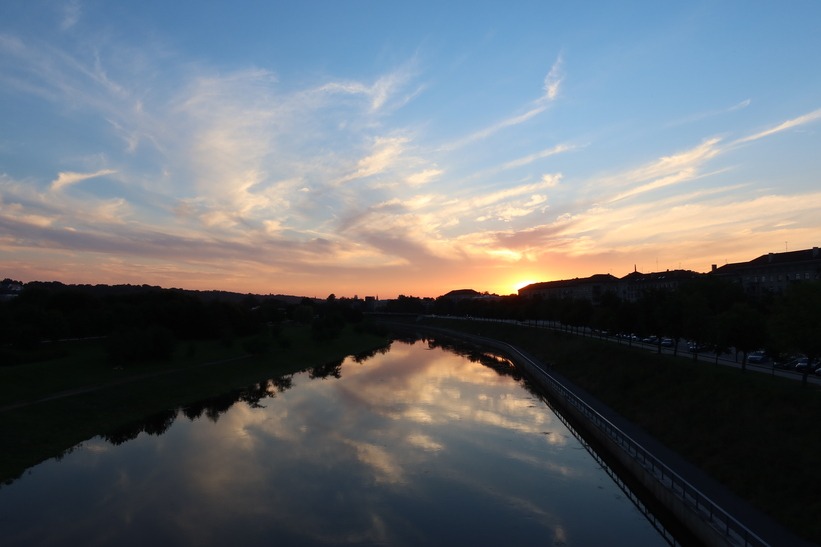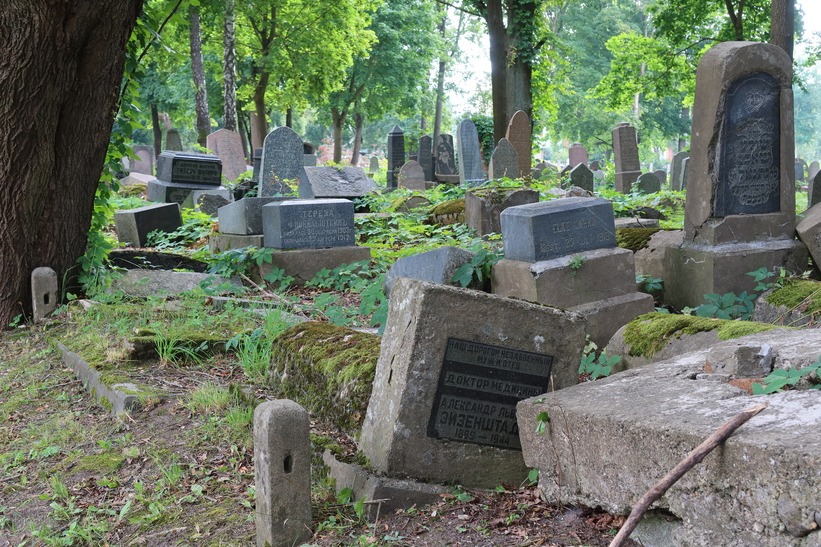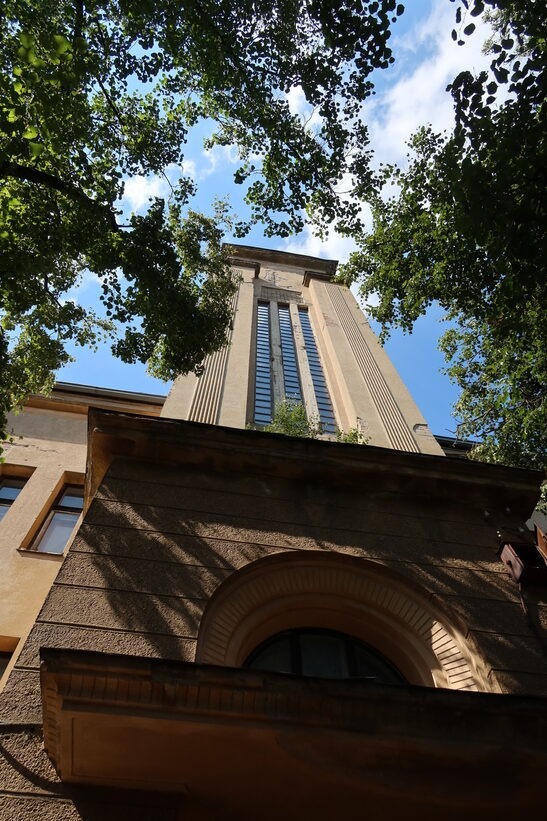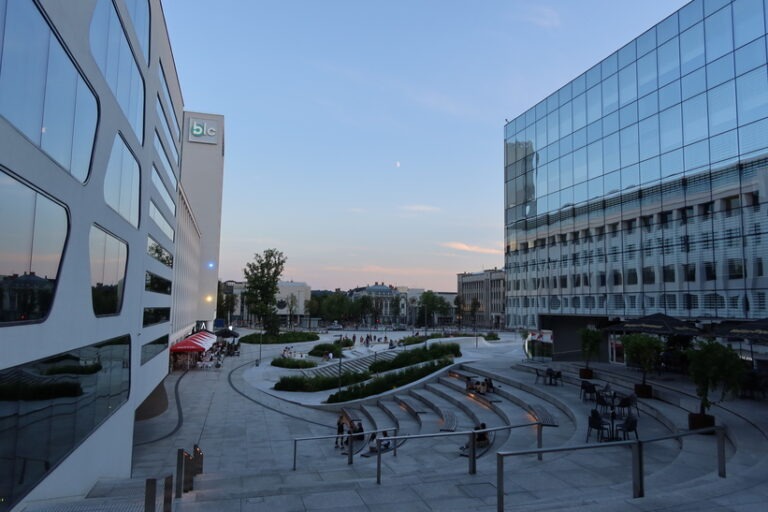I first went to Kaunas in the summer of 2005. I was backpacking through all three of the Baltic states, and, en route to Vilnius from the Hill of Crosses near Šiauliai, I spent a day or two in Lithuania’s second city. And didn’t like it at all. It took a second trip in 2022 to change my mind.
—–
“Kaunas? It’s a dump — don’t bother”, was my standard, withering response these last 17 years if anyone asked me where to go or what to visit in the Baltics. I did not enjoy my time in Kaunas. I recalled a run-down, grey and miserable city centre with gloomy, dilapidated buildings shedding bits of façade right, left and centre. So many disintegrating balconies! Still in use but looking just about ready to give in to gravity and plunge to the street, taking out anyone who might be standing on (or under) them. The clear impression was of a city still sunk deep in its post-Soviet depression.
Get me out of here
My accommodation did not help. Since I wasn’t exactly flush with cash at the age of 23, I had booked a kind of homestay in the city. An Airbnb before Airbnb existed, if you like. It was in the flat of a middle-aged lady who, while extremely hospitable, did not speak any English at all. Translation was the job of her son, who was brooding and did not seem to appreciate my presence too much. The whole thing was extremely awkward.
I spent the evening holed up in my bedroom, watching TV and marvelling at Lithuanian movie dubbing techniques. Elsewhere, different voiceover artists are used for each character in the film or programme. Their voices completely supplant those of the actors and actresses in the original audio recording. Lithuanian films use only a single voiceover artist to cover all characters — with the original voices still audible in the background.
Perhaps it is due to a lack of funds, but it is highly distracting. That evening, “The Others” was on telly: a 2001 film starring Nicole Kidman as a woman who moves into a haunted house. Being a thriller involving ghosts and restless spirits, Kidman gets to do a fair amount of on-screen screaming and squawking. To hear this rendered in the voiceover by the rather demotivated grunts of a gravelly-voiced Lithuanian male was surreal to say the least.
I was glad to get on the bus the next day and head off to the decidedly more twinkly Vilnius.
Kaunas: European Capital of Culture 2022
With my negative opinion of Kaunas pretty much entrenched, I was surprised to hear that it had been chosen as one of the European Capitals of Culture for 2022. Wow, I thought — the place must have really improved! Perhaps it is time to go and take another look?
An opportunity presented itself soon enough. Both my partner and I are keen walkers and have been members of the International Marching League (IML) for several years. This organisation holds walking events in different countries around the world, from South Korea to Croatia. Participants can collect stamps for completing walks, which go towards awards, e.g. for having completed a certain number of walks in a given region. We saw that the Baltic Walker’s Association holds such an event every year in Kaunas and registered right away.
And thus, in August 2022, off we flew to Lithuania! And Kaunas was our first port of call.
The changes in the city since my last visit were immediately apparent. The town centre is now buzzing with new shops, bars and cafés, with lots of young people strolling around and soaking up the afternoon sunshine. Major public spaces had been cleaned up and regenerated. The whole place seemed far more lively, colourful and vibrant than the city I had been happy to write off 17 years earlier. I was eager to dive in and explore. Why not start in very British fashion with a trip to the pub?

Best of brewing
Now, I’m going to be honest here and say that the standard of food offered in the restaurants in Lithuania is still a bit hit-and-miss. The same goes for customer service. Food is frequently overpriced and tasteless. Customer service is often gruff, as if being nice to paying clientele is an onerous requirement. But we were not disappointed with our visit to Rebel’s Irish pub, located at the end of Laisvės alėja with a splendid view of St. Michael the Archangel’s church. This is a great place and I recommend it wholeheartedly to anyone visiting Kaunas.
I ordered Chicken Kiev as a main course, which was superbly done; as was the pear crumble we shared for dessert. As veteran craft beer fans, we were obviously keen to sample the local brews. We loved the special Lithuanian IPAs which the pub was offering in connection with a nationwide “IPA day” (which had been earlier that week). Now, ANY country that has a national “IPA day” is going to get a million brownie points from me right off the bat — but the beers genuinely were top notch. The Lithuanians know exactly what they are doing on that front.
The excellent service provided by our assigned waiter rounded off an all-round great experience. The guy knew his brews, could up-sell like a pro — and his (strongly American accented) English was perfect. When I complimented him on his language skills, he looked a little bashful and said “thanks, I studied in Wales”. That’ll explain the accent, then.
Stunning street art in Kaunas
My research on Kaunas prior to our trip had informed me that Kaunas is one of Europe’s premium destinations for fans of street art. A number of quirky works of various dimensions adorn the city’s streets. The tourist office provides a free map showing their locations so you can create your own walking tour to see them all. The most moving of these murals is the one located at A. Mickevičiaus str. 30, just off the Laisvės alėja.
This work by the Lithuanian artist Tadas Vincaitis-Plūgas portrays two of the city’s former Jewish residents, Rosian Bagriansky and her mother, Greta. The text is an excerpt from a poem by the Hirsh Osherovitch, a well-known Lithuanian Jewish poet. Before WWII, Kaunas had a thriving Jewish community of almost 37,000 people. After the war, only 3,000 of them remained — the rest had either been murdered in the Holocaust or had emigrated. Happily, Rosian and her mother survived. The work is part of the efforts of modern Kaunas to remember and honour its former residents.
Traces of a lost community
For those interested in finding out more about Kaunas’s Jewish heritage, you can visit one of several Jewish cemeteries, including the Žaliakalnis cemetery. This green, shady space covering 8 hectares contains the graves of many of the city’s former Jewish elite. It remained in use until 1952, after which it fell into a state of disrepair. Recent years have seen a drive to return the cemetery to a respectable state — which appeared to have been maintained at the time of our visit. While the perimeter fence was broken and rusting away, the site itself was free of rubbish and reasonably well tended to.
While walking amongst the old, lichen-encrusted headstones bearing Lithuanian, German and Russian names in both Latin and Cyrillic scripts, an elderly lady approached us. Speaking in very broken English, she asked us where we were from. At first, I thought she might be annoyed that we were taking photographs. Actually, she was just pleased that two people from so far away would show interest in this forgotten community in a minor European city. We were touched.

An architectural pot of gold
As I said, one of the reasons I didn’t like Kaunas initially was the dire state of a lot of the buildings. So many brutal-looking concrete structures that seemed to suck up all the surrounding light and be ready to casually drop a kilo or ten of mortar on your head at any second. However, what I had completely failed to appreciate in 2005 was the underlying architectural and historical value of many of these downtrodden-looking buildings.

Back when Lithuania first declared its independence after World War I, the country’s territory followed very different lines. Vilnius and the surrounding area were occupied by Poland as part of a dispute which rumbled on until the Lithuanians finally regained the city in 1939. During this time, Kaunas served as the temporary capital of Lithuania. With its rich cultural and academic life, lively café culture and cutting-edge art deco architecture, it even earned the nickname “Little Paris”.
OK, so those buildings I scoffed and grumbled at a few years ago? They are actually architectural gems! Nothing less than the expression of a brand-new country setting out its stall in the world. They just need a little love and care now to restore them to their former glory.
Trying not to think about what a terrible philistine I was at 23, I found new appreciation for Kaunas while wandering its streets. The Bank of Lithuania building. The Central Post Office. The Pažanga office building. The gigantic church of Christ’s Resurrection, towering above the confluence of the rivers Nemunas and Neris. It’s an embarrassment of riches and it would have been embarrassing not to fully appreciate it this time around.

So, Kaunas, my old friend: I would like to apologise. I know you were going through some rough times when we first met. But I should have taken the time to look past the (crumbling art deco) façade. There is so much history, art, culture and creativity in this little city coming back to life after the drubbings of the 20th century. Make sure to put it on the itinerary of your Baltic holiday.
(P.S. The weird one-voice film dubbing hasn’t changed at all!)
—–
Related articles:
Lednice castle – what does a faux minaret have to do with a pencil?
